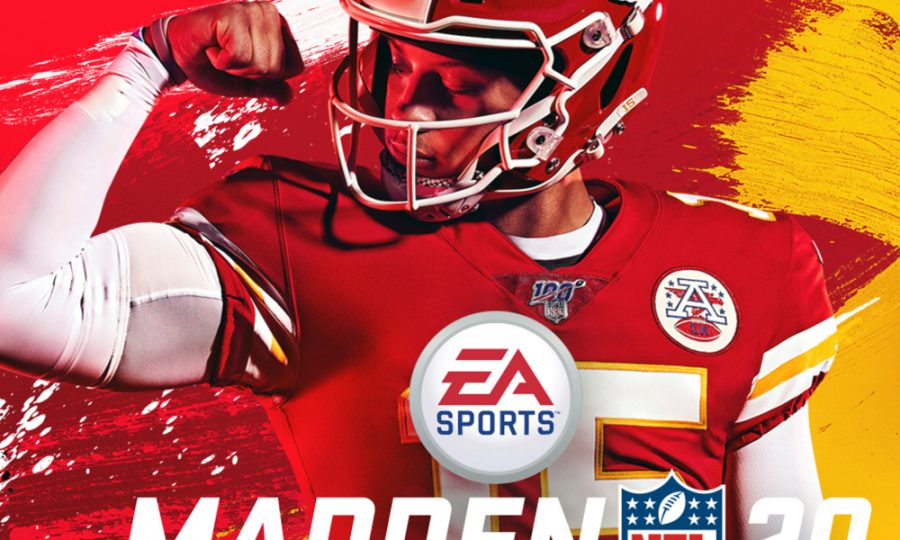The Madden Curse is real
This image provided by EA Sports shows the cover of the Madden 20 video game, featuring Kansas City Chiefs quarterback Patrick Mahomes, which will be released in August | (Photo courtesy of EA Sports via AP) ORG XMIT: NY161
October 22, 2019
When reigning MVP and Kansas City Chiefs’ quarterback Patrick Mahomes went down in the second quarter of Thursday’s game against the Denver Broncos, you could almost hear a collective groan throughout the NFL community. Mahomes, who has set the league ablaze since being drafted two years ago, is the latest Madden cover athlete to succumb to injury, joining a long list of predecessors. Such a development begs the question: at what point do we start acknowledging the legitimacy of the Madden Curse?
1999: Garrison Hearst
Prior to the 1999 edition of Madden, namesake Joe Madden used to grace the cover. However, going into the new millennium, the Madden gamemakers decided to transition to actual NFL athletes in order to lend a sense of credibility and novelty to the brand. They selected 49ers’ running back Garrison Hearst as the first ever cover athlete. At the time, Hearst appeared to be on a Hall of Fame trajectory, having just broke the Roger Craig’s 1988 franchise record for most rushing yards in a season (1,570 yards to Craig’s 1,502). That season, Hearst led the 49ers to the postseason, where he broke his ankle. Hearst would go onto miss the next two seasons with avascular necrosis. The Madden Curse had begun.
2000: Barry Sanders/Dorsey Levens
Next up was future Hall of Famer Barry Sanders, who initially graced the cover of “Madden 2000”, only to retire before the season began. EA Sports actually had to re-release the game with Green Bay Packers’ running back Dorsey Levens as their cover athlete. Levens would subsequently injure his knee. After recording 1,034 rushing yards in 1999, Levens would never again surpass 500 rushing yards in a season.
2001: Eddie George
While Tennessee Titans’ running back Eddie George was able to evade injury, a costly bobble against the Baltimore Ravens would cost the Titans the Super Bowl. However, George’s aggregate rushing yards dropped from 1,509 in 2000 to 939 in 2001. Still productive, but a significant drop off.
2002: Daunte Culpepper
The 2001-02 season was a disaster for Culpepper. After 11 games in which he went 4-7, Culpepper went down with a knee injury. He would be the first cover athlete to suffer an injury during the regular season. The next season, he returned as a shell of himself, going 6-10 with a league-leading 23 interceptions
2003: Marshall Faulk
After gracing the cover of Madden, Marshall Faulk would suffer an ankle injury that would hamper him for the remainder of his career. In 2002-03, Faulk would miss two games, costing him his streak of five consecutive 1,000-yard rushing seasons. His stats would gradually decline until he retired in 2005.
2004: Michael Vick
Michael Vick was the cover athlete who really brought attention to the possibility of a Madden Curse. The day after it was announced that Vick would be named the Madden cover athlete, the Falcons’ quarterback broke his fibula, costing him 11 games. Two years later, Vick would be suspended indefinitely for violating the league’s personal conduct policy. Soon after, Vick pled guilty for his involvement in a dog fighting ring. Vick would spend 21 months in a federal penitentiary.
2005: Ray Lewis
Ray Lewis would become the first defensive player to grace the cover of Madden. Unfortunately, the curse struck again, as Lewis would go on to break his wrist. Though he only missed one game, Lewis would finish the 2004-05 season with zero interceptions for the first time in his career. The next season, Lewis would miss 10 games with a thigh injury.
2006: Donovan McNabb
2005-06 would be the year that the drama between Donovan McNabb and Terrell Owens manifested itself. Though McNabb was enjoying a solid, if unspectacular, season through nine games, he injured himself in Week 9, costing him the rest of the season. Prior to his injury, McNabb had a 4-5 record with 2,507 yards, 16 touchdowns and 9 interceptions
2007: Shaun Alexander
Shaun Alexander was unstoppable for the Seattle Seahawks, earning him cover honors in 2007. In 2005-06, Alexander led the league in yards (1,880) and touchdowns (27, then an NFL record). The next season, he collected 896 yards and seven touchdowns before breaking his foot. Two years later, he was out of the league.
2008: LaDainian Tomlinson Vince Young
LaDainian Tomlinson was supposed to be the Madden cover athlete, but was released from that obligation once fans vehemently petitioned against it. Apparently, Tomlinson obliged, citing an insufficient financial incentive as his reasoning. Instead, Vince Young received the honor, leading to a sophomore slump that he would never recover from. In 2007-08, Young threw for a meager nine touchdowns against 17 interceptions. Despite Young’s substandard play, the Titans still made the playoffs. However, the next season, he was relegated to backup duties in favor of 36-year-old Kerry Collins.
2009: Brett Favre
In between the time that Favre was announced as the Madden cover athlete and the season opener, Favre would retire, get traded to the Jets and then unretire. The game initially released with Favre in a Packers’ uniform, only to offer an alternate version with Favre donning the Jets’ green and white. Favre would go on to throw a league-leading 22 interceptions while playing with a torn bicep that cost the Jets four of the final five games and a postseason berth.
2010: Troy Polamalu and Larry Fitzgerald
For the first time ever, two stars shared the cover of Madden. Polamalu would go on to miss seven games due to injury, though he played exceptionally well in the remaining nine. However, after winning the Super Bowl the previous season, the Steelers would miss the playoffs. Fitzgerald would lead the league with 13 touchdowns, though a rib injury would keep him out for the entirety of the playoffs.
2011: Drew Brees
Some say the Madden curse didn’t hit Drew Brees while others point out some startling shortcomings which suggest otherwise. Brees would go on to pass for over 4,600 yards and 33 touchdowns. However, his 22 interceptions were a career high. Furthermore, the Saints would go on to lose to the 7-9 Seahawks in the playoffs after entering the game as the largest betting favorites in NFL history. The Seahawks, if you’re wondering, were the only team to ever make the postseason with a losing record. They would lose to the Chicago Bears the very next week.
2012: Peyton Hillis
For the first time ever, Madden allowed their cover athlete to be decided by a fan vote, which was won by Cleveland Browns’ running back Peyton Hillis. While Hillis was not an established star, he did manage to run for 1,177 yards in 2010. In 2011, Hillis would suffer a plethora of hamstring injuries, missing six games and never surpassing 600 yards again during his career.
2013: Calvin Johnson
Calvin Johnson, for a time at least, was considered to be the man that broke the Madden Curse. “Megatron,” as Johnson is fondly referred to as, led the league in both receptions and yards, defying what was previously believed to be an undeniable curse.
2015: Richard Sherman
2014’s Madden cover was Barry Sanders, who had retired 14 seasons prior, so we can’t consider him cursed. However, like Johnson, Sherman would also defy the daunting curse. Though he only recorded four interceptions (compared to eight in 2013-14), his coverage abilities remained elite, subsequently deterring teams from targeting him.
2016: Odell Beckham Jr.
For a third straight season, a Madden cover athlete eluded the curse, forcing fans to consider whether or not it was dead once and for all. The New York Giants’ Odell Beckham Jr. caught 96 passes for a career-high 1,460 receiving yards and 13 touchdowns, earning him his second consecutive Pro Bowl appearance.
2017: Rob Gronkowski
The curse awoke from its hibernation is 2016-17, targeting New England Patriots’ tight end Rob Gronkowski. “Gronk” missed the first two games of the season before returning to play at a high level. However, a back injury cost Gronkowski the final six games of the season. Gronkowski would later cite a spate of injuries as the reason behind his premature retirement at age 29.
2018: Tom Brady
Tom Brady is untouchable. As weird as it is to think that Brady had never been named the Madden cover athlete prior to his age 41 season, the Patriots’ quarterback would go on to throw for 4,355 yards and 29 touchdowns, winning his sixth Super Bowl in the process.






